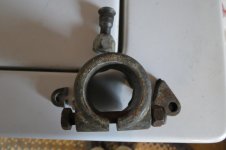Today a Corvair friend gave me a ride to Canton, ME, where I picked up my new-to-me '80 Spitfire. The car had been stored for many winters in a barn, and this past winter, in a shop owned by a mechanic in that town. It turns out I'm the second registered owner of the car; indeed, it came with a "Passport to Service" that registered the car in the name of the original owner. It was purchased at Tom Connelly Pontiac by a man who lived in Norwood, MA, on 3/30/81.
I brought a tow strap, an electrical kit, a socket set and a tool bag, along with some vital fluids. I started up the car and listened from problems - none were evident - so we headed back the 80 miles to the coast. The two lane roads provided a perfect test for the car. It stumbled under acceleration for a mile [no wiggle from the tach, though] so I stopped on the side of a farm road and poured in some Marvel Mystery Oil into the gas tank.
Within a few minutes the driving smoothness improved and I really enjoyed re-acquainting myself with a Spitfire [my last one was a 1978, owned between 1989 - 1998]. The car ran very well until we hit traffic in Augusta, ME, when the temperature climbed to 3/4. Happily, I watched it sink back as the fan must have kicked on and reduced the coolant temperature.
I made it to the ferry terminal without incident until - cue the drum roll - I pushed the clutch to move the car into the ferry line. Suddenly it locked up; by that I mean you could not push the pedal in at all. I rolled the car down an incline and into a parking space. Nothing would seem to free the clutch. The clutch and transmission had been working very smoothly and without any graunching, but now, it felt as if there was a metal to metal interference. Pulling back the boot on the clutch master showed that the linkage looked clean and fresh (new cotter pin, shiny bits showing) but I could not see anything else, nor could I get underneath the car.
I had to call a tow truck to get the car and take it to a shop. What are the possibilities here?
Thanks,
Jeff

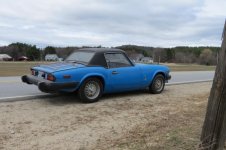
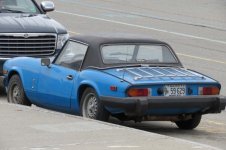
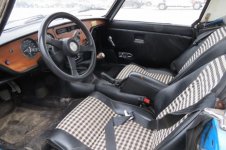
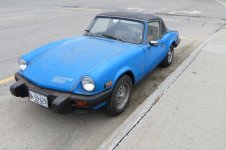
I brought a tow strap, an electrical kit, a socket set and a tool bag, along with some vital fluids. I started up the car and listened from problems - none were evident - so we headed back the 80 miles to the coast. The two lane roads provided a perfect test for the car. It stumbled under acceleration for a mile [no wiggle from the tach, though] so I stopped on the side of a farm road and poured in some Marvel Mystery Oil into the gas tank.
Within a few minutes the driving smoothness improved and I really enjoyed re-acquainting myself with a Spitfire [my last one was a 1978, owned between 1989 - 1998]. The car ran very well until we hit traffic in Augusta, ME, when the temperature climbed to 3/4. Happily, I watched it sink back as the fan must have kicked on and reduced the coolant temperature.
I made it to the ferry terminal without incident until - cue the drum roll - I pushed the clutch to move the car into the ferry line. Suddenly it locked up; by that I mean you could not push the pedal in at all. I rolled the car down an incline and into a parking space. Nothing would seem to free the clutch. The clutch and transmission had been working very smoothly and without any graunching, but now, it felt as if there was a metal to metal interference. Pulling back the boot on the clutch master showed that the linkage looked clean and fresh (new cotter pin, shiny bits showing) but I could not see anything else, nor could I get underneath the car.
I had to call a tow truck to get the car and take it to a shop. What are the possibilities here?
Thanks,
Jeff






 Hi Guest!
Hi Guest!

 smilie in place of the real @
smilie in place of the real @
 Pretty Please - add it to our Events forum(s) and add to the calendar! >>
Pretty Please - add it to our Events forum(s) and add to the calendar! >> 

